
Choosing a Japanese anemone
Our buying guide to make the right choice
Contents
Japanese anemone, also known as the autumn anemone, forms a lovely clump with a compact, rounded habit, animated by sturdy stems that vary in height depending on the variety, adorned with solitary flowers in soft shades of pink and white. From June to November, enjoy this highly floriferous perennial and let yourself be charmed. With varying heights, early or late flowering, and a range of colours, it can be grown in pots or borders—many criteria to consider.
Before acquiring a Japanese anemone, read these tips to choose the right one for your needs!
Discover our wide range of Japanese anemones
According to its height
There are dozens of varieties of Japanese anemones. Their height ranges from 40 cm for the smallest to 1.5 m for the tallest. Therefore, you will not grow the same varieties if you wish to flower a border or a pot on a balcony.
Japanese anemones can be classified into three categories:
Small – between 40 and 60 cm tall
One can mention ‘Little Summer Breeze’, the smallest of all at 35 cm in height. In the tribe of Japanese anemones not exceeding 40 cm in height, we find ‘Fantasy Cinderella’, ‘Elfin Swan’, or ‘Fantasy Jasmine’ which enliven a border, placed in the foreground or in pots on a terrace. Finally, there are anemones measuring 50 and 60 cm tall, such as the varieties ‘Wild Swan’, ‘Dreaming Swan’, or ‘Little Princess’ which add height when associated with larger anemones, asters, or perennial chrysanthemums.
Medium – between 70 cm and 1 m tall
The vast majority of Japanese anemones belong to this category. Their intermediate height allows for colour and height combinations to create stunning borders or seasonal pots. Embrace pink with the varieties ‘Prinz Heinrich’, ‘Hadspen Abundance’, or ‘Margaret’ and white with ‘Ruffled Swan’ or ‘Tiki Sensation’.
Tall – over 1.5 m
Utilise their tall, slender, ramified, and sturdy stems that bear small solitary double or single flowers, pink or white, to green up the back of a border. Here are varieties that can grow up to 1.2 m, such as ‘Andrea Atkinson’, ‘Honorine Jobert’, ‘Rosenschale’, or ‘Whirlwind’. Finally, the Japanese anemone ‘Rubra Plena’, the tallest of the varieties, can reach 1.5 m in height!
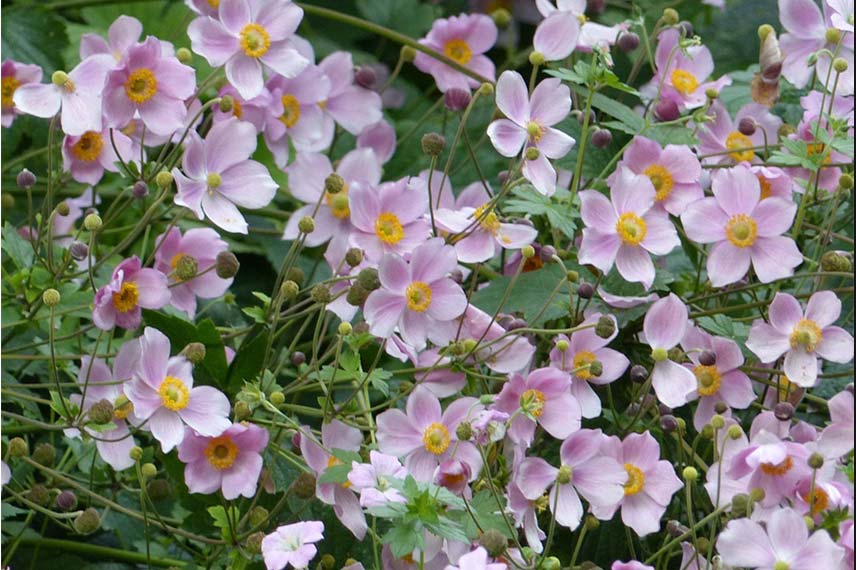
Autumn anemone ‘September Charm’
According to the colour of the flowers
Japanese anemones offer stunning summer and autumn flowerings in a variety of shades. Their sturdy stems bear solitary flowers with a yellow stamen centre, which varies in prominence depending on the varieties. Here’s a brief overview of the different colours you can find:
- Pink-flowered anemones with a yellow centre are the most standard colour, featuring varieties such as ‘Fantasy Pocahontas’, ‘Fantasy Cinderella’, ‘Hadspen Abundance’, or ‘September Charm’. There are shades with purplish-pink in the variety ‘Prinz Heinrich’, the pearly raspberry pink of ‘Mont Rose’, and stunning bicoloured anemones, pink with a purple-violaceous reverse, such as ‘Dainty Swan’ and ‘Rosenschale’.
- White is also a highly sought-after colour, and there is a wide selection of white anemones. Pure whites can be found with ‘Andrea Atkinson’, ‘Snow Angels’, or ‘Dreaming Swan’. For something more original, try the mauve-washed white with a strong reverse of ‘Wild Swan’ or ‘Ruffled Swan’.
Whether planted in full sun or partial shade, the shades of pink and white reveal changing tones depending on the seasons and light conditions.
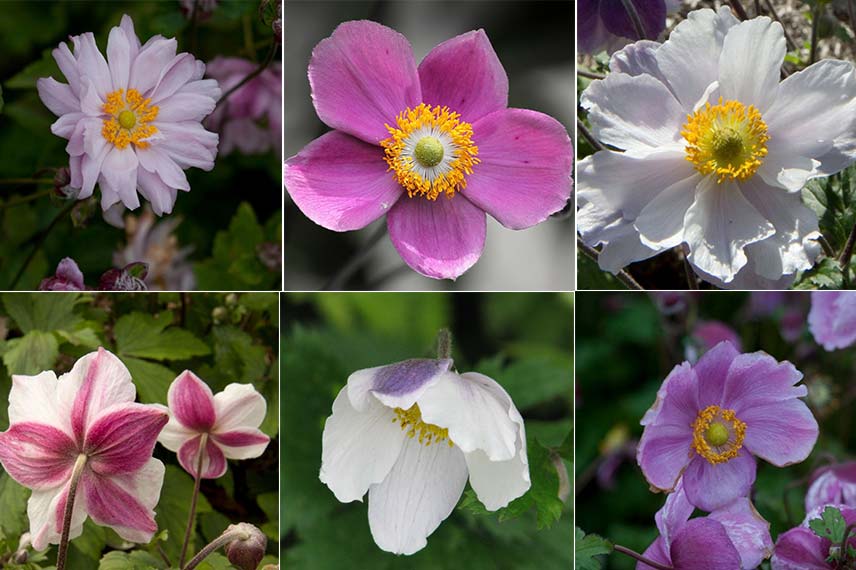
Colour palette featuring anemone ‘Mont Rose’, hupehensis ‘Praecox’, ‘Dreaming Swan’ (top, left to right) and anemone ‘Dainty Swan’, ‘Wild Swan’, ‘Rosenschale’ (bottom, left to right)
Discover other Japanese Anemones
View all →Available in 0 sizes
Available in 0 sizes
Available in 0 sizes
Available in 1 sizes
Available in 3 sizes
Available in 3 sizes
Available in 1 sizes
Available in 1 sizes
Available in 4 sizes
Available in 1 sizes
According to the shape of the flowers
The light and graceful flowers of Japanese anemones bloom in various forms, revealing single, double, and semi-double corollas. The petals can be smooth or frilled like ‘Fantasy Pocahontas’ or ‘Mont Rose’.
Single flowers
The most classic form among Japanese anemones, pink varieties like ‘Little Princess’, ‘Septemberglanz’, or white Japanese anemones like ‘Honorine Jobert‘ or ‘Pretty Lady Maria’.
Semi-double flowers
You can choose to grow semi-double flowered anemones in pink, such as ‘Serenade’, ‘Rubra Plena’, or ‘Pamina’, and in white like ‘Snow Angels’.
Double flowers
Less common but more spectacular, you can acquire double-flowered anemones, both pink with the variety ‘Queen Charlotte’ and white with the variety ‘Whirlwind’ or ‘Tiki Sensation’.
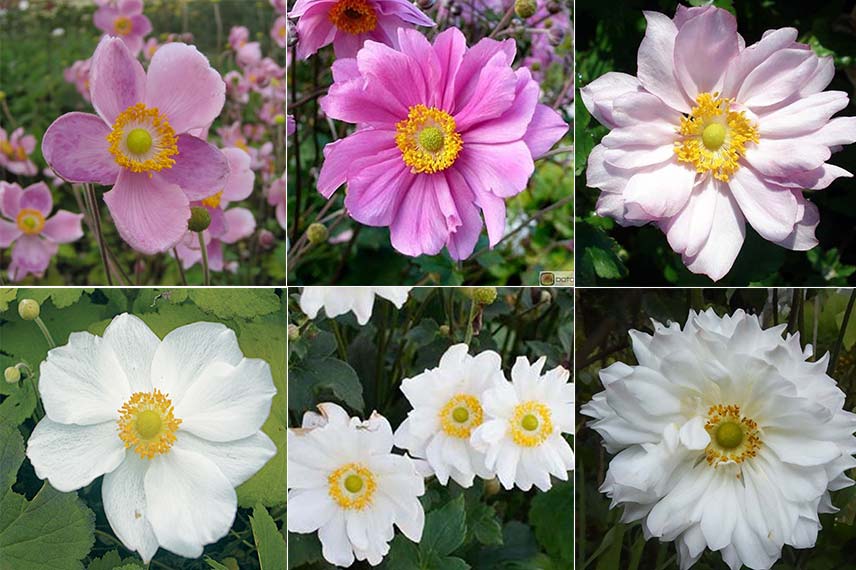
Selection of forms with anemone ‘Little Princess’, ‘Serenade’, ‘Princess Charlotte’ (top, left to right) and anemone ‘Honorine Jobert’, ‘Snow Angels’, ‘Tiki Sensation’ (bottom, left to right)
According to the flowering period
Perennial anemones typically flower between August and October, but you can extend the flowering period by mixing early and late varieties. Floriferous and perennial, you can enjoy their delicate little flowers from June until the first cold snaps of winter, which can be as late as November.
Here are some tips to increase the flowering period:
- with early varieties that start to emerge as early as June and continue until October, such as ‘Wild Swan’ or ‘Ruffled Swan’
- with summer-flowering varieties, which begin to bloom in July and continue until October by choosing ‘Dainty Swan’, ‘Elfin Swan’, ‘Fantasy Jasmine’, or ‘Robustissima’
- with autumn-flowering varieties like ‘Fantasy Cinderella’ or ‘Rubra Plena’, which will bloom in September and October
- with late varieties such as ‘Fantasy Pocahontas’, ‘Pamina’, or ‘Little Princess’, which will flower from August until November.
According to sucker propagation
Is Japanese anemone invasive? This perennial takes up more or less space and spread once planted and established. Whether in the ground or in a pot, the anemone develops suckers, similar to roots that grow. Depending on the varieties, anemones can be quite invasive. Therefore, it is important to do your research.
It is through these suckers that a Japanese anemone will spread. Unlike other suckering plants, the anemone does not smother its companions in a border. If you notice that a clump of anemone becomes too troublesome in your garden or in a pot, divide it to keep it in check.
According to the use
The final use of Japanese anemones will depend on their size. Opt for short varieties such as ‘Little Summer Breeze’ to flower a rock garden, ‘Fantasy Cinderella’, ‘Elfin Swan’, ‘Fantasy Jasmine’, ‘Dreaming Swan’, or ‘Little Princess’ for pot cultivation or to create the foreground of a flower bed with carex, hardy geraniums, and heucheras. Potted Japanese anemones will bring lightness, graphic appeal, and movement to a corner of a terrace, patio, courtyard, or balcony.
Conversely, use tall varieties, between 1 and 1.5 m such as ‘Andrea Atkinson’, ‘Honorine Jobert’, ‘Rosenschale’, ‘Whirlwind’, or ‘Rubra Plena’, the tallest of the varieties, to create the background of a mixed border, mixed with asters, hydrangeas, miscanthus, autumn chrysanthemums, calamagrostis, or bush roses.

Japanese anemone ‘Honorine Jobert’
For further reading
- Discover more staging ideas with our article Japanese Anemones: 8 Ideas for successful combinations
- To learn everything about Japanese anemone, find our complete article Japanese Anemone: Planting and care and How to grow a Japanese Anemone in a pot?
- Subscribe!
- Contents


































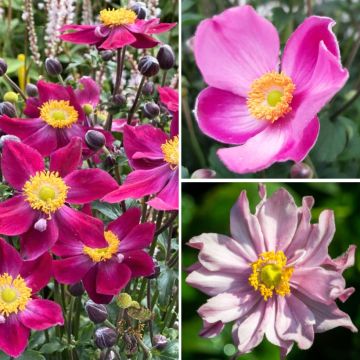
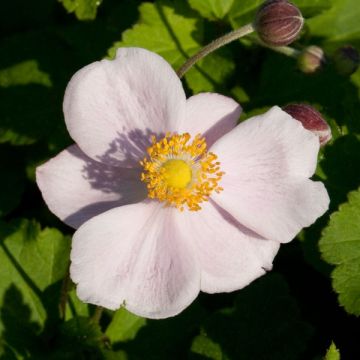
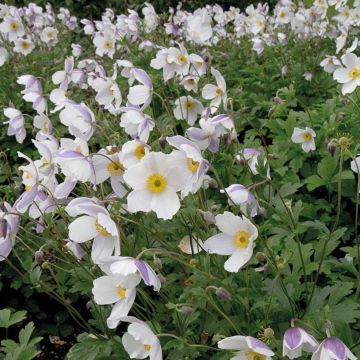
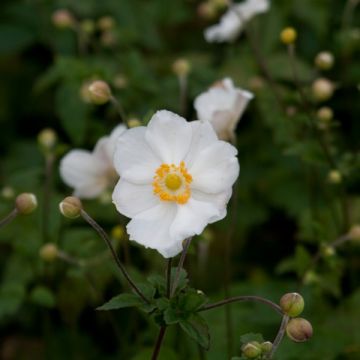

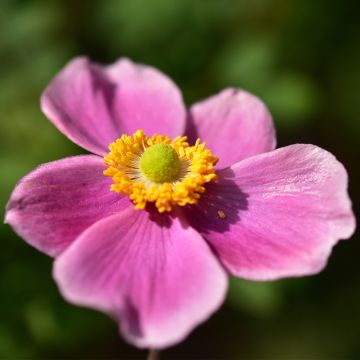
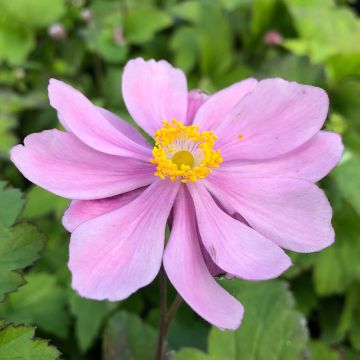
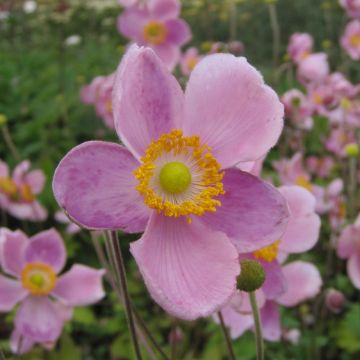
Comments